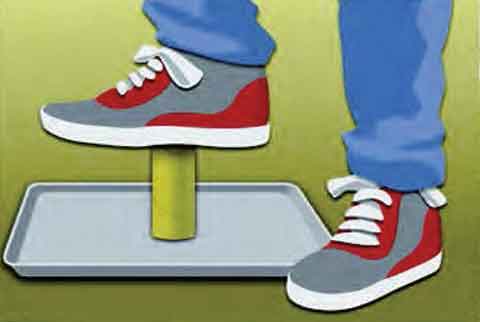Overview
STEM careers
Grade level
Time
Materials
Per Group of 2-3 Students:
- 3 toilet paper tubes
- Sand or salt
- Marbles or pebbles
- Dishpan, tray, or cardboard box lid
- Masking tape
- Sturdy chair
- Funnel
Instructions
Students explore the load-bearing properties of columns by testing different materials with toilet paper tubes.
- Give each group their materials and tell them to do the following steps.
- Place your dishpan, tray, or box top on the floor near the back of a sturdy chair. Stand a toilet paper tube on its end in the pan.

- Holding onto the back of the chair, put your foot on the tube and gradually press. Keep pressing until the column collapses.
- Inspect the column to see where it failed. Predict how much stronger the column will be if you add tape and sand. Test your prediction.
- What if you filled the tube with bigger particles, like marbles or pebbles? Make a prediction and test it with the third toilet paper tube.
Guiding questions
-
How much force did it take to crumple the empty toilet paper tube: not much, some, pretty much, or a lot?
-
What was the difference in the amount of force it took to crumple a tube that was taped and filled with sand, versus one filled with marbles or pebbles?
-
If you were an engineer designing a column to support a very heavy load, what would you conclude was the way to make it strongest, based on these tests?
-
Can you think of any other loads on a column that might occur? (Wind)
Engineering & science connections
- Columns are vertical structural members designed to pass through a compressive load. Columns pass the load from above (ceiling, roof, or beam) to the structural elements below (foundation). The load pushes on the column and compresses it. If a structural column collapses, the entire structure may collapse.
- Columns are one of the basic building blocks of any frame building. Engineers have to design columns that are very strong under compression in order to keep buildings safe. Columns can be made from stone, wood, steel, brick, marble, or other composite materials. Columns have been a common structural feature of buildings throughout history, but some of them are now designed to be purely decorative and are hollow or even made from foam!
- The tallest building in the world is the Burj Dubai at 2,722 feet tall. It was built using concrete columns and floors. When a building is this tall, the compressive strength of the columns is extremely important, but an engineer must also consider lateral (sideways) loads.
- Some of the earliest civilizations to employ the use of columns were the Minoans. The Minoans made columns out of whole tree trunks that they turned upside down (to prevent regrowth). Caps and bases made of stone or wood were fitted on the ends of each column and then painted.
This activity is from American Society of Civil Engineers: Building Big.


0 Comments